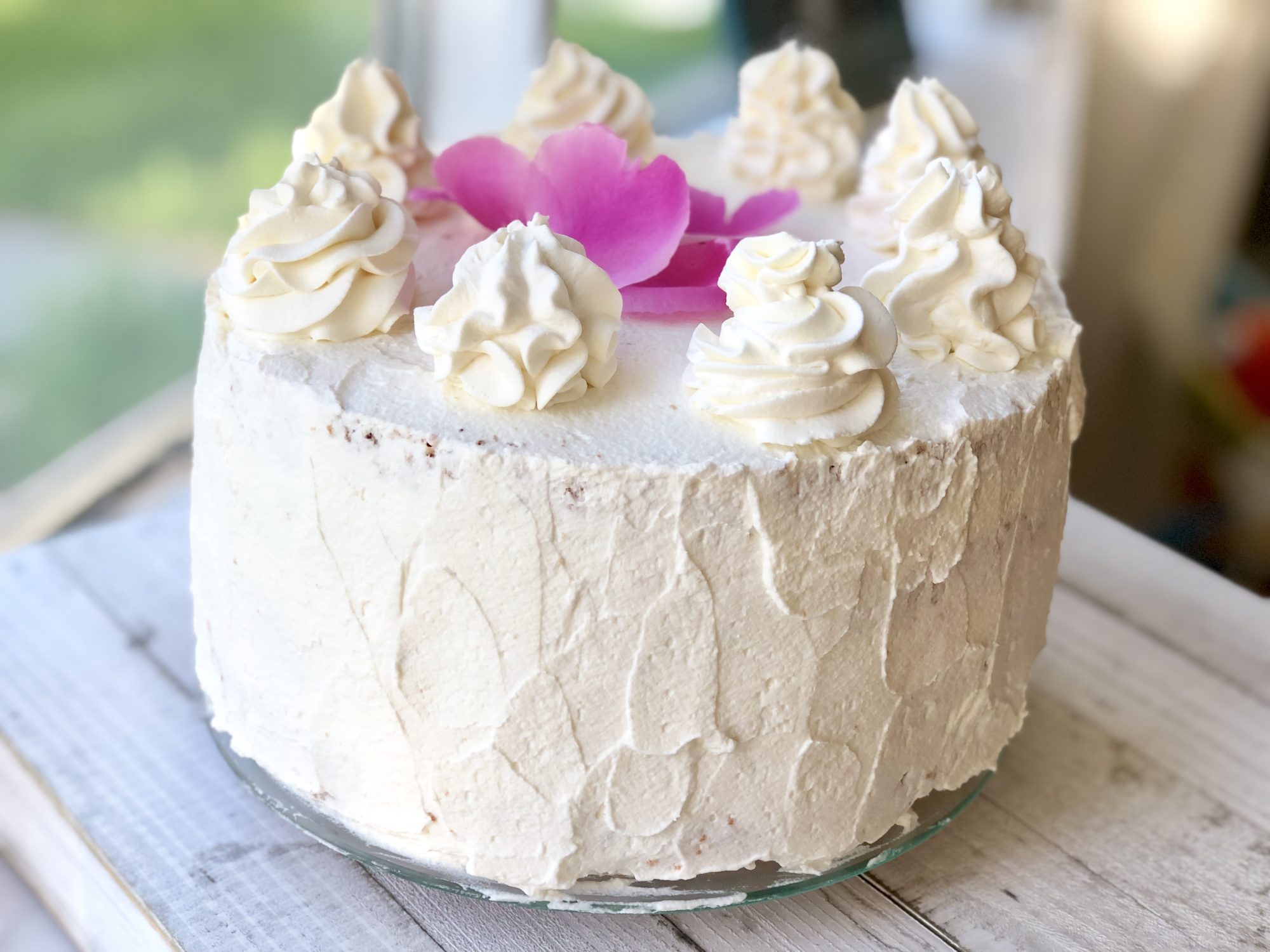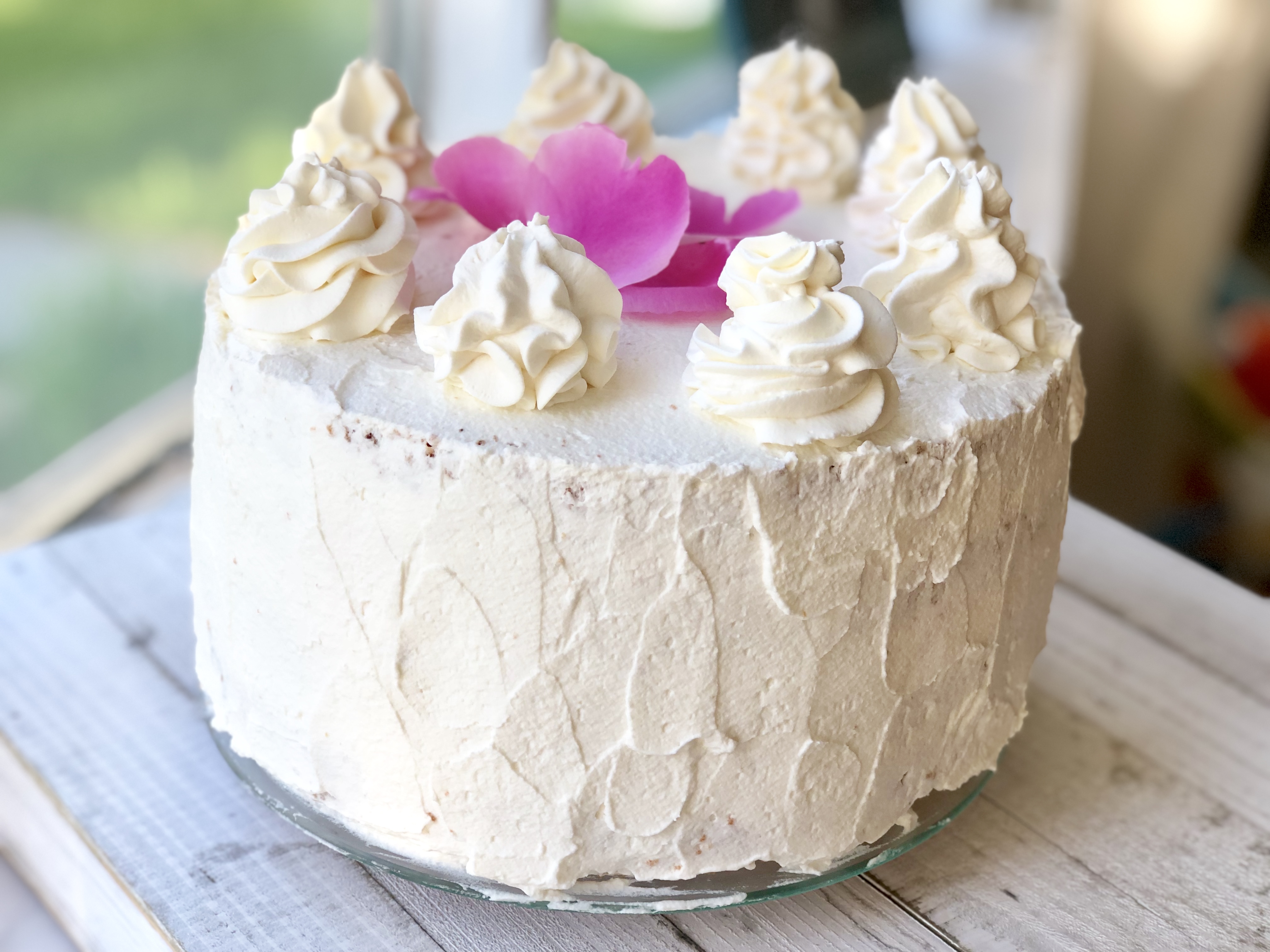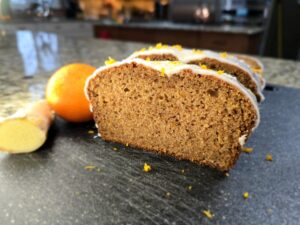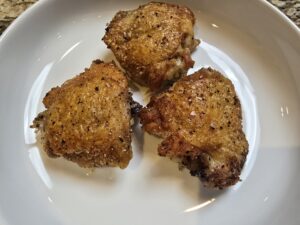
Preheat the oven to 325F. Make sure your 10 inch angel food tube pan is totally clean. Do not grease or line it in any way.
When the oven is preheated, lay your pecans on a baking sheet in a single layer and toast them in the oven for about 10 minutes until toasted and fragrant. Remove from the oven and set aside.
When you separate your egg yolks and egg whites, please note, that if your egg yolk breaks and makes it into your whites - they will not whip up properly and the cake will not turn out. For this reason, I suggest separating each egg over a small bowl then transferring it to separate yolks and whites bowls. If your egg yolk happens to break and leak - do not use it. Reserve it for an omelet or another use.
Measuring the flour correctly is very important. Spoon the flour into the cup measure and shave off the excess flour with a butter knife without compressing it into the cup measure. Flour is very compactable, so if you simply scoop it out of the bag and not spoon it in, you will end up getting a lot more flour than needed and turning this delicate cake into a dense one. So do not skip this extra step.
Sift flour, baking powder and salt into a small bowl. In another bowl, whisk the liquid components together.
Beat egg whites with a whisk attachment of your stand mixer on medium-high speed until frothy, about 2 minutes. Add cream of tartar and continue whipping until soft peaks form, about 3 minutes. Gradually add the sugar with the mixer running on medium speed. It’s crucial to add the sugar slowly for the meringue to properly form, do so for a period of about 2 minutes. Beat until you reach stiff glossy peaks, around 4 minutes. Do not overbeat. When this is overbeat, your meringue won't be smooth. Transfer your meringue to another bowl and set aside.
No need to wash the bowl of your mixer after step 4, simply wipe it with a paper towel. Add egg yolks and beat them until thickened, for about 2 minutes. Gradually add sugar on high speed. Beat for another 2 minutes until lighter in colour and thickened. On medium speed, pour in the oil. Then add vanilla and lemon zest. Stop the mixer, scrape up the sides, then beat everything for another 1 minute to combine.
Add the dry ingredients with the mixer running on lowest speed, alternating with the liquids, dividing the flour into 3 parts and the liquid into 2 parts, starting and ending with the flour. Scrape the bowl with a rubber spatula. Then beat everything on low speed for 10 seconds.
Gently fold 1/3 of the whipped egg whites into the egg yolks with a whisk this will lighten the batter and make it easier to fold in the rest. Fold in the rest of the egg whites, as well as cooled toasted pecans, into the yolk mixture with a rubber spatula. Only fold until uniform in colour and combined; do not fold any more than necessary. Pour the batter into the ungreased tube pan.
Bake in preheated oven for about 55-60 minutes. The cake should be nice and golden, firm to touch and spring back when gently pressed in the centre. Look for the internal temperature of 206 measured with an instant read digital thermometer. Remove from the oven. If your pan has legs, open them up and place the cake upside down to cook (this will take about 2 hours.) If your pan doesn't have legs, find 3 cans (beans, tomatoes, whatever) and prop up the pan upside down over the cans.
Place all of the icing ingredients in the bowl of a stand mixer and whip. When the icing is thickened but does not yet hold stiff peaks, taste it. If you wish, add more sugar at this point. Continue whipping for about 4 minutes to stiff peaks (but stop beating as soon as stiff peaks are reached as you are not making butter here!)
Gently run a butter knife between the cake and the pan. Using an offset spatula gently try to loosen the cake from the bottom as well. Gently remove the cake from the pan. Slice your cake horizontally into 3 layers. Ice each layer with 25% of the icing. You are looking to make the icing layer 1/2-3/4" inch thick. You should have icing left for garnish.
If using 1/2 cup chopped pecans, sprinkle 1/4 cup over the first layer and 1/4 cup over the second layer. Ice the top and sides of the cake with leftover icing and garnish with whole pecans. Sprinkle shredded coconut, if desired.
Drizzle the cake with he butterscotch sauce. Be sure to also drizzle each individual slice with some additional butterscotch sauce, or serve some butterscotch sauce on the side with each slice. Refrigerate the cake for 4 hours. But no more than 8 hours. The leftovers will still store in the fridge for a couple of days, however, the best texture is when the cake is refrigerated between 4 and 8 hours.
Your sauce will foam and bubble up quite a bit, so be sure to use a medium pan and not a small one.
Add butter and sugar and heat on medium heat, swirling the pan and infrequently stirring the sauce with a rubber spatula, around 3 minutes. The sauce should become quite smooth and fluid and no longer look grainy. In other words, you are looking to ensure the sugar has dissolved.
Add cream and reduce the heat to medium low. Stir constantly with a heat resistant spatula and cook for 7-8 minutes until the temperate of the caramel reaches 225. After a minute of cooking, turn your heat up back to medium heat.
Remove from heat and stir in vanilla and heaping 3/4 teaspoon coarse salt. Allow to cool for about 5 minutes as the sauce will be extremely hot. Taste it and see if you wish to add a bit more salt. Salt brings an interesting dimension to this sauce, so don't be afraid to add more.
If this sauce separates, warm it up in a sauce pan and whisk until smooth.
Ingredients
Directions
Preheat the oven to 325F. Make sure your 10 inch angel food tube pan is totally clean. Do not grease or line it in any way.
When the oven is preheated, lay your pecans on a baking sheet in a single layer and toast them in the oven for about 10 minutes until toasted and fragrant. Remove from the oven and set aside.
When you separate your egg yolks and egg whites, please note, that if your egg yolk breaks and makes it into your whites - they will not whip up properly and the cake will not turn out. For this reason, I suggest separating each egg over a small bowl then transferring it to separate yolks and whites bowls. If your egg yolk happens to break and leak - do not use it. Reserve it for an omelet or another use.
Measuring the flour correctly is very important. Spoon the flour into the cup measure and shave off the excess flour with a butter knife without compressing it into the cup measure. Flour is very compactable, so if you simply scoop it out of the bag and not spoon it in, you will end up getting a lot more flour than needed and turning this delicate cake into a dense one. So do not skip this extra step.
Sift flour, baking powder and salt into a small bowl. In another bowl, whisk the liquid components together.
Beat egg whites with a whisk attachment of your stand mixer on medium-high speed until frothy, about 2 minutes. Add cream of tartar and continue whipping until soft peaks form, about 3 minutes. Gradually add the sugar with the mixer running on medium speed. It’s crucial to add the sugar slowly for the meringue to properly form, do so for a period of about 2 minutes. Beat until you reach stiff glossy peaks, around 4 minutes. Do not overbeat. When this is overbeat, your meringue won't be smooth. Transfer your meringue to another bowl and set aside.
No need to wash the bowl of your mixer after step 4, simply wipe it with a paper towel. Add egg yolks and beat them until thickened, for about 2 minutes. Gradually add sugar on high speed. Beat for another 2 minutes until lighter in colour and thickened. On medium speed, pour in the oil. Then add vanilla and lemon zest. Stop the mixer, scrape up the sides, then beat everything for another 1 minute to combine.
Add the dry ingredients with the mixer running on lowest speed, alternating with the liquids, dividing the flour into 3 parts and the liquid into 2 parts, starting and ending with the flour. Scrape the bowl with a rubber spatula. Then beat everything on low speed for 10 seconds.
Gently fold 1/3 of the whipped egg whites into the egg yolks with a whisk this will lighten the batter and make it easier to fold in the rest. Fold in the rest of the egg whites, as well as cooled toasted pecans, into the yolk mixture with a rubber spatula. Only fold until uniform in colour and combined; do not fold any more than necessary. Pour the batter into the ungreased tube pan.
Bake in preheated oven for about 55-60 minutes. The cake should be nice and golden, firm to touch and spring back when gently pressed in the centre. Look for the internal temperature of 206 measured with an instant read digital thermometer. Remove from the oven. If your pan has legs, open them up and place the cake upside down to cook (this will take about 2 hours.) If your pan doesn't have legs, find 3 cans (beans, tomatoes, whatever) and prop up the pan upside down over the cans.
Place all of the icing ingredients in the bowl of a stand mixer and whip. When the icing is thickened but does not yet hold stiff peaks, taste it. If you wish, add more sugar at this point. Continue whipping for about 4 minutes to stiff peaks (but stop beating as soon as stiff peaks are reached as you are not making butter here!)
Gently run a butter knife between the cake and the pan. Using an offset spatula gently try to loosen the cake from the bottom as well. Gently remove the cake from the pan. Slice your cake horizontally into 3 layers. Ice each layer with 25% of the icing. You are looking to make the icing layer 1/2-3/4" inch thick. You should have icing left for garnish.
If using 1/2 cup chopped pecans, sprinkle 1/4 cup over the first layer and 1/4 cup over the second layer. Ice the top and sides of the cake with leftover icing and garnish with whole pecans. Sprinkle shredded coconut, if desired.
Drizzle the cake with he butterscotch sauce. Be sure to also drizzle each individual slice with some additional butterscotch sauce, or serve some butterscotch sauce on the side with each slice. Refrigerate the cake for 4 hours. But no more than 8 hours. The leftovers will still store in the fridge for a couple of days, however, the best texture is when the cake is refrigerated between 4 and 8 hours.
Your sauce will foam and bubble up quite a bit, so be sure to use a medium pan and not a small one.
Add butter and sugar and heat on medium heat, swirling the pan and infrequently stirring the sauce with a rubber spatula, around 3 minutes. The sauce should become quite smooth and fluid and no longer look grainy. In other words, you are looking to ensure the sugar has dissolved.
Add cream and reduce the heat to medium low. Stir constantly with a heat resistant spatula and cook for 7-8 minutes until the temperate of the caramel reaches 225. After a minute of cooking, turn your heat up back to medium heat.
Remove from heat and stir in vanilla and heaping 3/4 teaspoon coarse salt. Allow to cool for about 5 minutes as the sauce will be extremely hot. Taste it and see if you wish to add a bit more salt. Salt brings an interesting dimension to this sauce, so don't be afraid to add more.
If this sauce separates, warm it up in a sauce pan and whisk until smooth.










